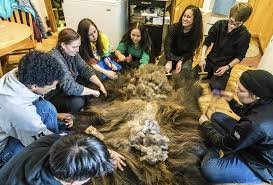
In the vast frozen wilderness of Alaska, where icy landscapes stretch for miles under an endless sky, there are spirited communities and resilient individuals striving to thrive. At the heart of these communities lie non-profit organizations, the beating pulse of social change and cultural preservation for the indigenous Alaskan Native people. These organizations, like the delicate wildflowers that dot the Alaskan tundra during summer, play a crucial role in supporting the well-being of their people. However, access to financial resources can be as scarce as the sun during an Alaskan winter, often hindering their ability to fully blossom and reach their potential. It is amidst this landscape that small grants emerge as a lifeline, a nurturing hand extended to these non-profits, empowering them to continue their vital work and uplift their communities.
– Empowering Grassroots Impact: Small Grants Foster Indigenous Empowerment
Small Grants Foster Indigenous Empowerment
Grassroots organizations in Alaska are thriving thanks to the impact of small grants. By providing much-needed financial support, these funds enable indigenous non-profits to address crucial community issues, such as:
- Preserving Cultural Identity: Grants support language revitalization programs, cultural workshops, and customary knowledge preservation.
- Empowering Education: Small grants provide scholarships, educational materials, and support for indigenous youth academic pursuits.
- Improving Health and Well-being: Grants fund programs that address chronic health conditions, promote mental health, and provide access to healthcare.
- Economic Growth: grants stimulate local economies through job creation, entrepreneurial initiatives, and community business development.
- Environmental stewardship: Small grants support efforts to protect traditional lands, water, and air quality, ensuring the sustainability of indigenous communities and ecosystems.
– Equitable Funding Landscape: Addressing Barriers and Ensuring Accessibility
In alaska,Native American tribes and organizations are often underfunded and understaffed,facing barriers to accessing grants and resources. To address these inequities, the Alaska Native health Board (ANHB) launched a small grants program aimed at supporting the unmet needs of Alaska Native non-profits. The program provides flexible funding, technical assistance, and capacity-building opportunities, helping organizations strengthen their operations, expand their reach, and positively impact their communities.
Examples of funded projects:
| Organization | Project | Description |
|—|—|—|
| southcentral Foundation | Food Security Project | Addressing food insecurity through food pantries and nutrition education programs. |
| Alaska Native Tribal Health Consortium | traditional Healing Program | Preserving and promoting traditional healing practices to improve mental and physical well-being. |
| Tanana Chiefs Conference | Language Revitalization Project | Supporting language revitalization efforts to preserve and strengthen Native languages. |
- Capacity Building Through Small Grants: Unleashing the Potential of Alaska Native Non-Profits
- Strategic planning and leadership: Grants can support non-profits in developing strategic plans, enhancing leadership skills, and improving organizational governance.
- Financial management and sustainability: Small grants can provide resources for non-profits to strengthen their financial management practices, develop lasting revenue streams, and improve reporting systems.
- Program evaluation and data management: Grants can enable non-profits to assess the effectiveness of their programs, improve data collection and analysis, and make data-informed decisions.
- marketing and communications: Small grants can support non-profits in developing and implementing effective marketing and communications strategies to increase visibility, engage with stakeholders, and promote their mission.
- Staff training and development: Grants can provide opportunities for staff to receive training, attend workshops, and gain valuable skills to enhance their capacity and improve program delivery.
final Thoughts
As we close this chapter on the pivotal support these grants provide to Alaska Native communities, it’s imperative to reflect on the transformative impact they have had and will continue to have. The ability of these non-profits to fulfill their vital missions — safeguarding cultural heritage, empowering individuals, and fostering economic resilience — is deeply intertwined with the availability of funding sources like these small grants. Let us celebrate their contributions and advocate for their continued support, ensuring that the vibrancy and strength of Alaska Native communities remains an enduring testament to the power of collective action and the spirit of philanthropy.